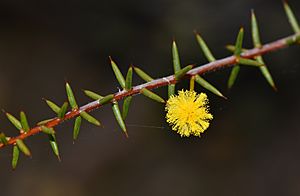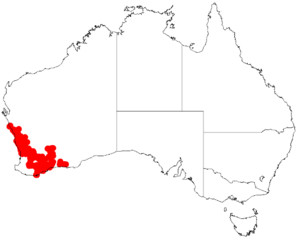Acacia sphacelata facts for kids
Quick facts for kids Acacia sphacelata |
|
|---|---|
 |
|
| Acacia sphacelatasubsp. sphacelata | |
| Scientific classification | |
| Genus: |
Acacia
|
| Species: |
sphacelata
|
 |
|
| Occurrence data from AVH | |
Acacia sphacelata is a type of shrub, a small woody plant, that belongs to the Acacia family. It's special because it only grows naturally in the southwestern part of Australia. This means it's endemic there, found nowhere else in the wild!
Contents
What Does Acacia sphacelata Look Like?
This tough shrub usually grows between 0.2 and 2.0 meters (about 8 inches to 6.5 feet) tall. It has bark that can be light grey or a medium grey color. Its branches are stiff and can be smooth (called glabrous) or have tiny hairs.
Like most Acacia plants, it doesn't have true leaves. Instead, it has special flattened stems called phyllodes. These phyllodes look like leaves and do the same job. They are scattered around the stem, often in circles (whorls). These evergreen phyllodes are usually straight or slightly curved. They can be square-shaped or flat, measuring about 6 to 25 mm long and 0.6 to 2 mm wide. They feel smooth, are stiff, and have five main veins.
Flowers and Seed Pods
Acacia sphacelata blooms from April to September, showing off bright yellow flowers. These flowers grow in round, ball-shaped clusters. Each cluster can have anywhere from 13 to 50 tiny, bright yellow flowers. These flower clusters usually grow by themselves where a leaf (or phyllode) meets the stem, on stalks that are 3 to 13 mm long.
After the flowers, thin, papery to slightly hard seed pods grow. These pods are long and narrow, up to 4 cm long and 2.5 to 7 mm wide. Inside, they hold dark brown to black seeds, each about 2.5 to 5 mm long. These seeds have a special fleshy part called an aril, which often helps with seed dispersal.
How Was Acacia sphacelata Named?
This plant was first officially described by a botanist (a scientist who studies plants) named George Bentham in 1842. He included it in a book called Notes on Mimoseae, with a synopsis of species.
Later, in 2003, another botanist named Leslie Pedley reclassified it, giving it a new name: Racosperma sphacelatum. However, in 2006, it was moved back into the Acacia family. Sometimes, plants have different names that mean the same thing; these are called synonyms. For Acacia sphacelata, some synonyms include Acacia sphacelata var. sphacelata, Acacia tamminensis, and Acacia spacelata.
Different Types of Acacia sphacelata
There are three different types, or subspecies, of Acacia sphacelata that scientists recognize:
- Acacia sphacelata subsp. recurva
- Acacia sphacelata subsp. sphacelata
- Acacia sphacelata subsp. verticillata
Where Does Acacia sphacelata Grow?
This plant is native to several regions in Western Australia. You can find it in the Mid West, Wheatbelt, and Goldfields-Esperance areas.
It often grows on gently rolling plains and on low hills made of a reddish soil called laterite. It prefers to grow in sandy soils, sandy-clay soils, and loamy soils (a mix of sand, silt, and clay). Most of these plants are found stretching from Port Gregory in the northwest, south to the Stirling Range, and east towards Scaddan.

